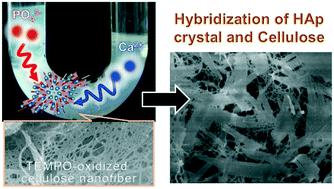当前位置:
X-MOL 学术
›
CrystEngComm
›
论文详情
Our official English website, www.x-mol.net, welcomes your feedback! (Note: you will need to create a separate account there.)
Growth of dispersed hydroxyapatite crystals highly intertwined with TEMPO-oxidized cellulose nanofiber
CrystEngComm ( IF 3.1 ) Pub Date : 2020-07-06 , DOI: 10.1039/d0ce00740d Tetsuya Yamada 1, 2, 3, 4 , Takeo Kitamura 4, 5, 6, 7 , Yuko Morita 4, 5, 6, 7 , Masahiro Mizuno 2, 3, 4, 8, 9 , Kunio Yubuta 4, 10, 11, 12 , Katsuya Teshima 1, 2, 3, 4, 8
CrystEngComm ( IF 3.1 ) Pub Date : 2020-07-06 , DOI: 10.1039/d0ce00740d Tetsuya Yamada 1, 2, 3, 4 , Takeo Kitamura 4, 5, 6, 7 , Yuko Morita 4, 5, 6, 7 , Masahiro Mizuno 2, 3, 4, 8, 9 , Kunio Yubuta 4, 10, 11, 12 , Katsuya Teshima 1, 2, 3, 4, 8
Affiliation

|
Hydroxyapatite (HAp) provides various attractive functionalities as a biomaterial and facilitates the formation of secondary particles that possess high surface area and durability, such as those used in adsorption columns. An effective approach for their design can be achieved by considering cellulose nanofibers (CNFs) as a template during hybridization to form a framework of secondary particles for HAp. However, the aggregation of HAp was not inhibited by using general CNFs. This study shows that (2,2,6,6-tetramethylpiperidine 1-oxyl) (TEMPO)-oxidized cellulose nanofiber (TOCN) assists in fabricating a dispersed crystalline HAp crystal to form a secondary particle. The growth of HAp in TOCN resulted in the formation of unique secondary particles, comprising dispersed and crystalline forms of HAp and TOCN, wherein they intertwined at an atomic level. This was not observed using other templates, such as bacterial cellulose nanofiber and agar. The chemical properties of TOCN and the gelation of a –COO–Ca2+–COO bridging bond even at diluted conditions, led to an interaction with HAp. The results obtained demonstrated the importance of selecting the proper template for designing a secondary particle composed of HAp crystals and the role of TOCN as a template to hybridize with the material, which possesses a multivalent cation in its composition.
中文翻译:

TEMPO氧化纤维素纳米纤维高度缠结的分散羟基磷灰石晶体的生长
羟基磷灰石(HAp)作为生物材料具有多种吸引人的功能,并有助于形成具有高表面积和耐用性的次级颗粒,例如用于吸附塔的次级颗粒。通过将纤维素纳米纤维(CNF)作为模板在杂交过程中形成HAp二级粒子框架的模板,可以实现有效的设计方法。但是,使用一般的CNF并不能抑制HAp的聚集。这项研究表明(2,2,6,6-四甲基哌啶1-氧基)(TEMPO)氧化的纤维素纳米纤维(TOCN)有助于制造分散的结晶HAp晶体以形成次级粒子。HAp在TOCN中的生长导致形成独特的次级颗粒,包括HAp和TOCN的分散和结晶形式,他们在原子层次上交织在一起。使用其他模板(如细菌纤维素纳米纤维和琼脂)未观察到此现象。TOCN的化学性质和–COO–Ca的凝胶化2+ –COO桥键即使在稀释条件下也导致与HAp相互作用。获得的结果表明,选择合适的模板来设计由HAp晶体组成的次级粒子的重要性,以及TOCN作为与材料杂交的模板的作用,该材料在其组成中具有多价阳离子。
更新日期:2020-07-27
中文翻译:

TEMPO氧化纤维素纳米纤维高度缠结的分散羟基磷灰石晶体的生长
羟基磷灰石(HAp)作为生物材料具有多种吸引人的功能,并有助于形成具有高表面积和耐用性的次级颗粒,例如用于吸附塔的次级颗粒。通过将纤维素纳米纤维(CNF)作为模板在杂交过程中形成HAp二级粒子框架的模板,可以实现有效的设计方法。但是,使用一般的CNF并不能抑制HAp的聚集。这项研究表明(2,2,6,6-四甲基哌啶1-氧基)(TEMPO)氧化的纤维素纳米纤维(TOCN)有助于制造分散的结晶HAp晶体以形成次级粒子。HAp在TOCN中的生长导致形成独特的次级颗粒,包括HAp和TOCN的分散和结晶形式,他们在原子层次上交织在一起。使用其他模板(如细菌纤维素纳米纤维和琼脂)未观察到此现象。TOCN的化学性质和–COO–Ca的凝胶化2+ –COO桥键即使在稀释条件下也导致与HAp相互作用。获得的结果表明,选择合适的模板来设计由HAp晶体组成的次级粒子的重要性,以及TOCN作为与材料杂交的模板的作用,该材料在其组成中具有多价阳离子。



























 京公网安备 11010802027423号
京公网安备 11010802027423号